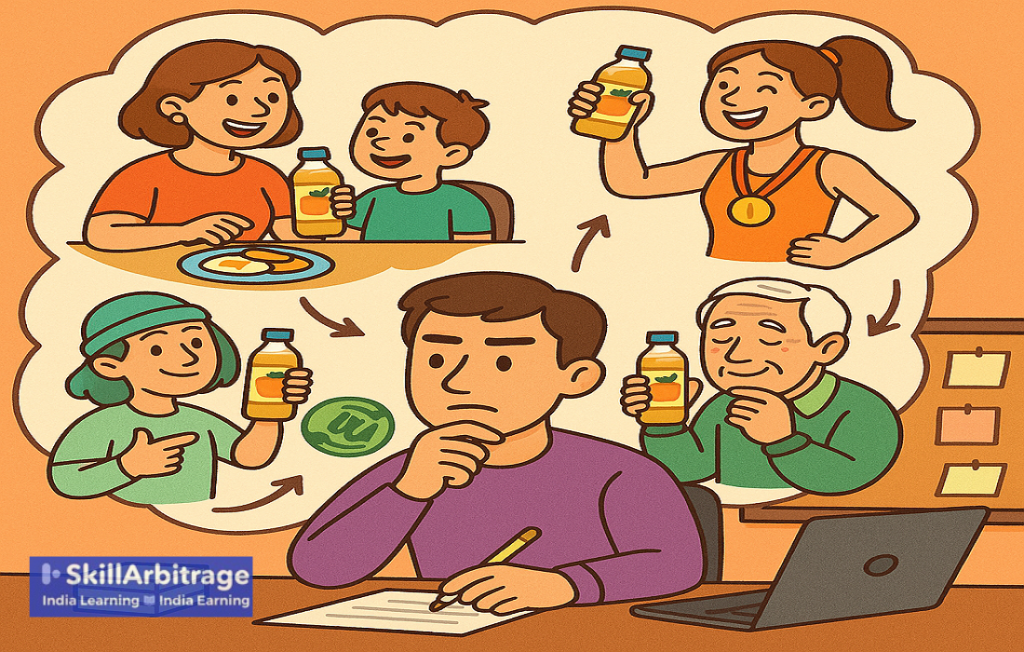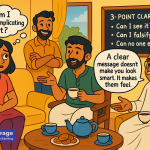In this blog, we will enter the magical world of emotionally triggering copy that moves products off the shelves like nobody’s business. This blog provides the reasons, step-by-step implementation, case studies, and challenges of crafting copy that triggers emotions and cuts the noise. It would be very useful for copywriters, marketing strategists, and SMB owners who want to use emotions to sell products really fast.
Table of Contents
Introduction
My mother had been screaming at me for weeks to buy her a juicer.
Why?
Something felt off about the store-bought orange juice. She wanted to make her own.
I took her to the mall, and instead of buying a juicer, she became a devotee of a juice company.
Why?
Well, let’s just say that their ad copy moved something in my mother’s heart–
“You cannot pluck oranges from your own yard anymore, but we do it with the same amount of care”.
And, suddenly it made sense. My mother did not have any issues with the previous juice either, but she just wanted an emotional trigger to buy/connect with the product.
Most buyers operate this way. As a copywriter, you need to know how to harness this trigger.
All the iconic brands have ruled the marketing world based on the power of emotions alone. Let us understand how.
Iconic brands and their mastery of emotionally triggering copy
Think back on all the iconic advertising campaigns you have seen, Nike with its powerful slogan “Just Do it!” or Dove with its incredibly inspiring message to the common woman with its “Real Beauty” Campaign.
Every bit of those campaigns were emotionally charged and demonstrated how such copies can drive sales and brand loyalty.
Here’s a closer look at some of these iconic campaigns.
Nike’s “Just Do It” Campaign (1988)
Launched in 1988, Nike’s “Just Do It” campaign inspired audiences to achieve their goals inspite of challenges. Featuring athletes and fitness enthusiasts, the campaign connected with everyday people striving for personal victories.
(Source: https://www.creativereview.co.uk/just-do-it-slogan/)
Impact: The campaign became Nike’s emblematic tagline, driving a huge sales boost within months and cementing Nike’s brand identity as a symbol of grit and perseverance. Thousands submitted personal stories of “just doing it,” from weight loss to career changes.
This campaign helped Nike leap to the forefront of the sportswear industry. In the first decade of the campaign, Nike’s sales grew from $877 million to $9.2 billion.
Coca-Cola’s “Share a Coke” Campaign (2011)
Coca-Cola replaced its logo with popular names on bottles, encouraging people to share a Coke with friends or loved ones. The campaign tapped into the joy of personal connection and community.
“Share a Coke with [Name].” The personalized call-to-action made consumers feel seen and invited them to create shared moments.
Impact: The campaign increased global sales and engagement, with millions sharing bottles and posting on social media. It became a global phenomenon, resonating across cultures.
In U.S. alone sales spiked to a 2% in the summer that it was launched.
3. Dove’s “Real Beauty” Campaign (2004)
Dove challenged beauty stereotypes by featuring unedited, diverse women in its ads, sparking conversations about self-esteem. The campaign empowered women to embrace their natural beauty.
“You are more beautiful than you think.” This line from the “Real Beauty Sketches” ad resonated deeply, affirming self worth for millions of women around the world.
(Source: https://youtu.be/rrHoDJinMQI)
Impact: The campaign influenced the beauty industry to embrace diversity, boosted Dove’s brand loyalty, and generated millions of social media shares. It remains a benchmark for authenticity.
The success of the campaign reflected in the revenues. The company increased revenues by 10% in a single year. And nearly 20 years later, the campaign is still running, with plans to expand to the virtual world as well.
I could go on sharing examples but the truth is staring at us in the face. Almost all the mammoths around the world have made advertising history with emotionally triggering copy, building pride, forging human bonds and compelling action.
Where most writers lose their way is when they start to think that some divine moment of inspiration must have happened during the crafting or maybe the scale of the campaign had anything to do with it.
Actually emotionally charged copy works great for small brands too. Take a look at these numbers.
Do you want to know how you can channelize this power for a small brand?
Just follow these simple steps.
Step-by-step crafting of emotional copy
Let’s go back for a second. Remember my tale of the orange juice? Now if you had to market a small orange juice brand like that on a limited budget how would you do it?
It all starts from imagining what the product means to the audience.
For example, the same orange juice might mean a happy breakfast table to a mother in her early 40s, to her athletic teen daughter it might mean a sports medal, to a Gen Z it might mean supporting a small brand and saving the environment, to a Boomer, it might mean reliving the authentic taste and freshness of their youth, and so on and so forth.
You have to identify who you are speaking to, figure out what really moves them, show them how people like them have already benefitted, and tell them they are going to miss out if they don’t act now.
Here is a complete step-by-step breakdown of the process. Let’s call our local, organic orange juice brand PurePulse.
Step 1: Define the goal and audience
What to do: Clarify the purpose (e.g., awareness, sales, loyalty) and who you’re targeting (age, pain points, desires).
How: Ask yourself, what’s the action I want (buy, click, share)? Who’s my ideal reader (e.g., busy moms, fitness buffs)? Use tools like surveys, X posts, or customer reviews to pinpoint their emotional state.
Example: Goal: Sell PurePulse Juice. Audience: Health-conscious 30-somethings who feel drained, betrayed by processed drinks, and nostalgic for authentic, natural flavors they can’t access.
Step 2: Identify the emotional trigger(s)
What to do: Pick 1-2 core emotions tied to your audience’s problem or dream (e.g., fear, joy, pride).
How: Map their pain points (e.g., “I’m exhausted”) and desires (e.g., “I want energy”) to psychological drivers like loss aversion, reward seeking, or belonging.
Example: Trigger: Grief and frustration from losing access to pure, natural foods (like hand-picked oranges) + Hope and empowerment from reclaiming authentic vitality.
Step 3: Research and empathize
What to do: Dig into what your audience feels and says about their situation.
How: Scour X for raw opinions (e.g., “Why’s every juice full of chemicals?”), read reviews, or imagine their day-to-day frustrations and wins. Write down their exact words or thoughts.
Example: “I miss the taste of real fruit, not this processed garbage.” “I’m so tired of fake juices that leave me crashing and cheated.”
Step 4: Craft the hook (Problem or Promise)
What to do: Start with a punchy opener that grabs attention by amplifying pain or teasing a reward.
How: Use the negativity bias (pain) or dopamine (anticipation). Keep it short, vivid, and tied to the trigger. Test questions, statements, or contrasts.
Example: “You can no longer pick your own oranges, so we did for you.”
Step 5: Agitate the pain
What to do: Describe the pain with sensory details.
How: Paint a relatable, insightful picture of their struggle. Use “you” to make it personal and use power words (e.g., “waste,” “stuck”) to heighten tension.
Example: “You’re trapped—sipping chemical-laden sludge that mocks your craving for real fruit, leaving you sluggish, betrayed, and aching for the pure taste you remember.”
Step 6: Present the solution (reward)
What to do: Introduce your product as the emotional antidote, shifting from pain to possibility.
How: Tie it to their desire with benefits, not features. Use imagery and aspirational language to trigger joy, pride, or trust. Add social proof for credibility.
Example: “PurePulse Juice is your way back—hand-picked oranges, squeezed fresh, flooding your body with vibrant energy and the honest taste you’ve missed. Over 7,000 fans swear by it.”
Step 7: Build urgency or stakes
What to do: Push the consumer to act instantly by raising the cost of inaction or adding scarcity.
How: Lean on FOMO (loss aversion) or time limits. Keep it believable—fake urgency flops.
Example: “Only 25 bottles remain from this grove’s harvest. Hesitate, and you’re back to swallowing fake juice that dulls your spark.”
Step 8: Close with a Call-to-Action (CTA)
What to do: End with a clear, emotionally charged directive that ties back to the trigger.
How: Use action verbs and reinforce the reward or loss. Make it personal and urgent: “your,” “now.”
Example: “Seize your PurePulse now and rediscover real energy, or stay stuck with tasteless lies.”
Step 9: Refine and test
What to do: Polish the copy for flow, then test it to see what hits hardest.
How: Read it aloud. Does it feel natural? Cut fluff. A/B test variations (e.g., fear-heavy vs. joy-heavy hooks) with tools like Google Ads or email splits. Check metrics (clicks, conversions).
Example: Test hooks like, “You can no longer pick your own oranges, so we did for you” vs. “Craving real juice but stuck with fakes?” to see which drives more engagement.
Here’s a quick recap.
- Hook: You can no longer pick your own oranges, so we did for you.
- Agitate: You’re trapped—sipping chemical-laden sludge that mocks your craving for real fruit, leaving you sluggish, betrayed, and aching for the pure taste you remember.
- Solution: PurePulse Juice is your way back—hand-picked oranges, squeezed fresh, flooding your body with vibrant energy and the honest taste you’ve missed. Over 7,000 fans swear by it.
- Urgency: Only 25 bottles remain from this grove’s harvest. Hesitate, and you’re back to swallowing fake juice that dulls your spark.
- CTA: Seize your PurePulse now and rediscover real energy, or stay stuck with tasteless lies.
This isn’t a formula to churn out robots, it’s a framework to channel human messiness into words that move. Each step digs into the psyche, turning feelings into momentum.
And if you manage to pull it off, it will work.
One properly executed emotionally charged campaign can change the present and future of a brand.
Benefits of brilliant emotionally triggering copy
Here are the reasons why emotionally triggering copy works when nothing else does.
Grab attention in a crowded market
Every day, we are surrounded by a lot of noise. Digital notifications, rabid discussions on X, or endless pictures of aesthetic cafes on Instagram, there is just so much happening in the digital world all the time. We need something special, like emotions, to cut through the noise.
A headline like “Stop Wasting Your Life on Junk” for an organic juice brand beats “Buy Our Product” for raw impact, any day.
Drives action faster
Triggers like fear (loss aversion) or joy (dopamine) create urgency, bypassing overanalysis. This translates to higher click-throughs, conversions, and sales because people act on impulse, not deliberation.
For example, “Last Chance to Feel Unstoppable” pushes quicker sign-ups than a bland “Register Today.”
Builds stronger brand loyalty
Emotional resonance (belonging, pride) ties the brand closely to the customer’s identity or values. Customers don’t just buy, they advocate, sticking around longer and spreading the word.
“You Are Part of Our Fight” fosters a tribe, not just a transaction.
Increases memorability
Emotionally charged experiences stick in the hippocampus, the memory hub.
It helps brands linger in their mind, boosting recall and repeat engagement.
For instance, a tear-jerking story about a customer’s turnaround outlasts a dry product spec list any day.
Amplifies the perceived value of a brand or product
Emotional benefits (confidence, relief) far outweigh features in perceived worth. The price point can be far higher than the actual value of the product, because of this difference. People generally pay for how it makes them feel, not just what it does.
“Own Your Power” on a Rs. 20 juice feels pricier than “100% Natural” alone, for example.
Creates shareable content
Strong emotions (anger, awe) compel people to share, driven by social validation. It led to explosive organic reach, reducing marketing costs.
“This Changed Everything for Me” sparks retweets many times over. “Here’s a Coupon.”
Here’s the diagram of how it all works.
These benefits are independent of the size of the brand, or the scale of the campaign. If you do it right, it will work, no matter how small the brand is.
However, small brands have some specific challenges, but the good news is there are also ways to mitigate them.
Small brand challenges and how emotionally triggering copy helps
Small brands face unique challenges when trying to compete in a crowded market, especially when writing emotionally triggering copy. But like Harry Potter in the Triwizard championship all of those challenges can be turned into strengths.
“ Play to your strengths Harry!” As Dumbeldore would say.
Challenges for small brands
Let’s go further with the orange juice example we have been using till now. What are the challenges that a brand like PurePulse might face when trying to craft an emotional campaign laden with triggers.
Limited budget and reach
Small brands can’t afford big ad campaigns or influencer deals, so their copy has to work harder with fewer impressions.
Emotional triggers might not hit if the audience never sees them or if the delivery feels cheap.
How to fix it:
Strategy: Borrowing credibility and building an identity fast.
How:
- Using social proof, even if small: “10 locals swear by us” beats nothing.
- Anchoring to a relatable founder story: “I was you, fed up and fighting back with this.”
- Using vivid, sensory language to create a memorable vibe: “Taste the rebellion in every sip.”
Example: “We’re not famous (yet)—just a crew of juice nerds who get it. Join us.”
Lack of brand recognition
Unlike Nike or Apple, small brands don’t have instant trust or a built-in fanbase to amplify emotional resonance.
New and small brands face distrust; customers wonder, “Is this legit?” or “Why haven’t I heard of them?”
Overly bold emotional claims (e.g., “Change your life!”) might feel manipulative without credibility.
How to fix it:
- Strategy: Focusing on high-impact, low-cost channels and lean into authenticity.
- How:
- Using platforms like X or email where concise, punchy copy shines (e.g., “Tired of fake promises? Try us—real results, no fluff.”).
- Embracing the underdog status—tap into relatability: “We’re small, scrappy, and obsessed with fixing this for you.”
- Repurposing one strong piece across channels (e.g., a story of “why we started” with pain-to-hope arc).
- Emotional trigger: Hope, trust—position your smallness as a strength, not a flaw.
- Example: “Big brands don’t care. We do, every bottle’s made for you.”
Narrow audience insight
Small brands often lack the data or research to deeply understand their audience’s pain points and desires.
Emotional triggers are missed if they’re generic or misaligned with what the audience actually feels.
How to fix it:
- Strategy: Starting small, listening hard, and iterating.
- How:
- Talking to the customers (DMs, quick calls) or scouring X for their gripes (e.g., “Why’s every drink a sugar bomb?”).
- Mirroring their exact words: “You’re tired of the lies—we are too.”
- Testing cheap, fast experiments (e.g., two X posts: fear-based vs. joy-based) to see what sticks.
- Emotional Trigger: Empathy, anger—showing that the brand gets their struggle intimately.
- Example: “You’re upset with fake health drinks. Us too—here’s our fix.”
Small brands can’t outspend giants, but they can outfeel them. By focusing on raw, real emotions, backed by trust and hustle, you mitigate the challenges and punch above your weight.
Conclusion
After diving deep into the art of emotionally triggering copy, one thing is clear: it’s not about pushing products—it’s about pulling people in. In this blog, you and I, together, have explored the psychology behind triggers like fear, joy, and belonging, mapped out a step-by-step process to craft copy that resonates.
We’ve also unpacked its benefits and how to especially mitigate small brand challenges.
The magic lies in balance—knowing the audience’s heartbeat, wielding emotions with precision, and grounding every line in authenticity. This isn’t just selling; it’s storytelling that stirs the soul, builds bonds, and inspires action.
So, take these tools, test them, and write not to close a deal but to open a connection.
When you move people, the sales follow—naturally, effortlessly, and lastingly.
FAQs
1. How do I identify which emotions are most likely to trigger my target audience?
To find the right emotional triggers, analyze:
Customer pain points and desires (from reviews, Reddit threads, forums).
Psychographics – Are they driven by fear of missing out, desire for status, or security?
Use tools like SparkToro, AnswerThePublic, or even TikTok comments.
Pro Tip: Match the emotion to the stage of the funnel. Use curiosity for TOFU, trust for MOFU, and urgency or relief for BOFU.
2. What’s the difference between emotional copy that works and emotional copy that manipulates?
The line is thin. Good emotional copy:
Highlights real emotions your customer is already feeling.
Offers a solution or outcome they genuinely want.
Manipulative copy:
Fabricates fear, guilt, or urgency.
Makes promises it can’t keep.
Authentic: “You’ve tried everything and still feel stuck. Let’s fix that together.”
Manipulative: “If you don’t act now, you’ll always be a failure.”
3. How do emotional triggers differ in B2B vs B2C copywriting?
B2C: Triggers are often personal → fear, guilt, aspiration, pride.
B2B: Triggers are often professional → credibility, job security, reputation, logic + emotion.
Example:
B2C copy: “Don’t let anxiety steal your sleep.”
B2B copy: “Reduce compliance risk and sleep better at night.”
4. How do storytelling frameworks amplify emotional impact in copywriting?
Storytelling activates the brain’s empathy center. Frameworks like the Hero’s Journey or Before-After-Bridge let you:
Show a relatable struggle (builds trust)
Paint an emotional transformation (evokes desire)
Insert the product as a tool, not the hero (customer = hero)
Example:
“Anxious, underpaid, and unheard—Sara took a leap of faith. Two months later, she was leading meetings and mentoring others. Here’s what helped.”
6. How do I test if my emotional copy is actually resonating with my audience?
Use: A/B testing for headlines, CTAs, or value props with different emotional tones.
Scroll heatmaps (Hotjar) to see which emotional blocks hold attention.
Surveys or open-ended feedback like “What part of this made you want to take action?”
Pro Insight: Monitor engagement drop-off points. If people bounce after an overly dramatic emotional hook, they may not trust you.
7. How much is too much? What’s the emotional saturation point in copy?
When:
The tone feels exaggerated or theatrical.
Readers feel overwhelmed or skeptical.
Emotions are pushed without concrete benefits or support.
Rule of Thumb:
Lead with emotion, land with logic. Anchor emotional statements in stats, proof, or action.
8. How do visuals and design support emotionally triggering copy?
Design acts as an emotional amplifier. For example:
Warm colors like red/orange = urgency, excitement.
Muted colors = calm, safety, trust.
Images of faces expressing emotion boost empathy.
Tip: Match font tone to emotion. Heavy, bold fonts create intensity. Light, serif fonts add softness or elegance.
9. What’s a checklist I can use to audit my emotional copy before publishing?
Are the emotions aligned with the customer’s true needs/pain?
– Does the story feel human, not scripted?
– Do visuals support the tone?
– Is there balance between emotion and logic?
10. How do I test emotional copy?
“Run A/B tests on LinkedIn ads with tools like Canva. Try ‘Feel the joy of savings’ vs. ‘Save now’ for Indian clients. Start with our free template!”
11. How do I write emotional copy for Indian audiences?
Focus on family, tradition, or aspiration.







 Allow notifications
Allow notifications
